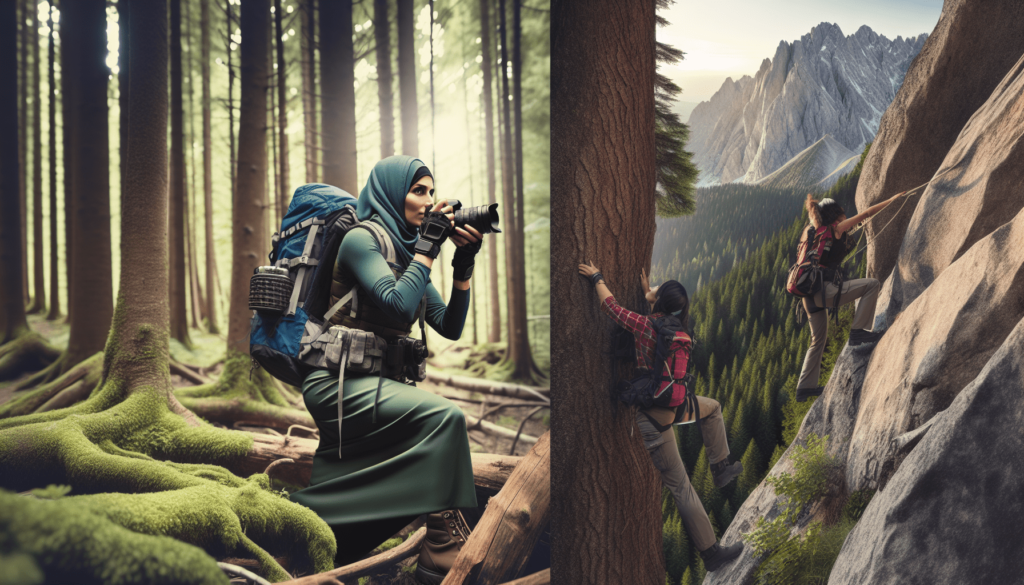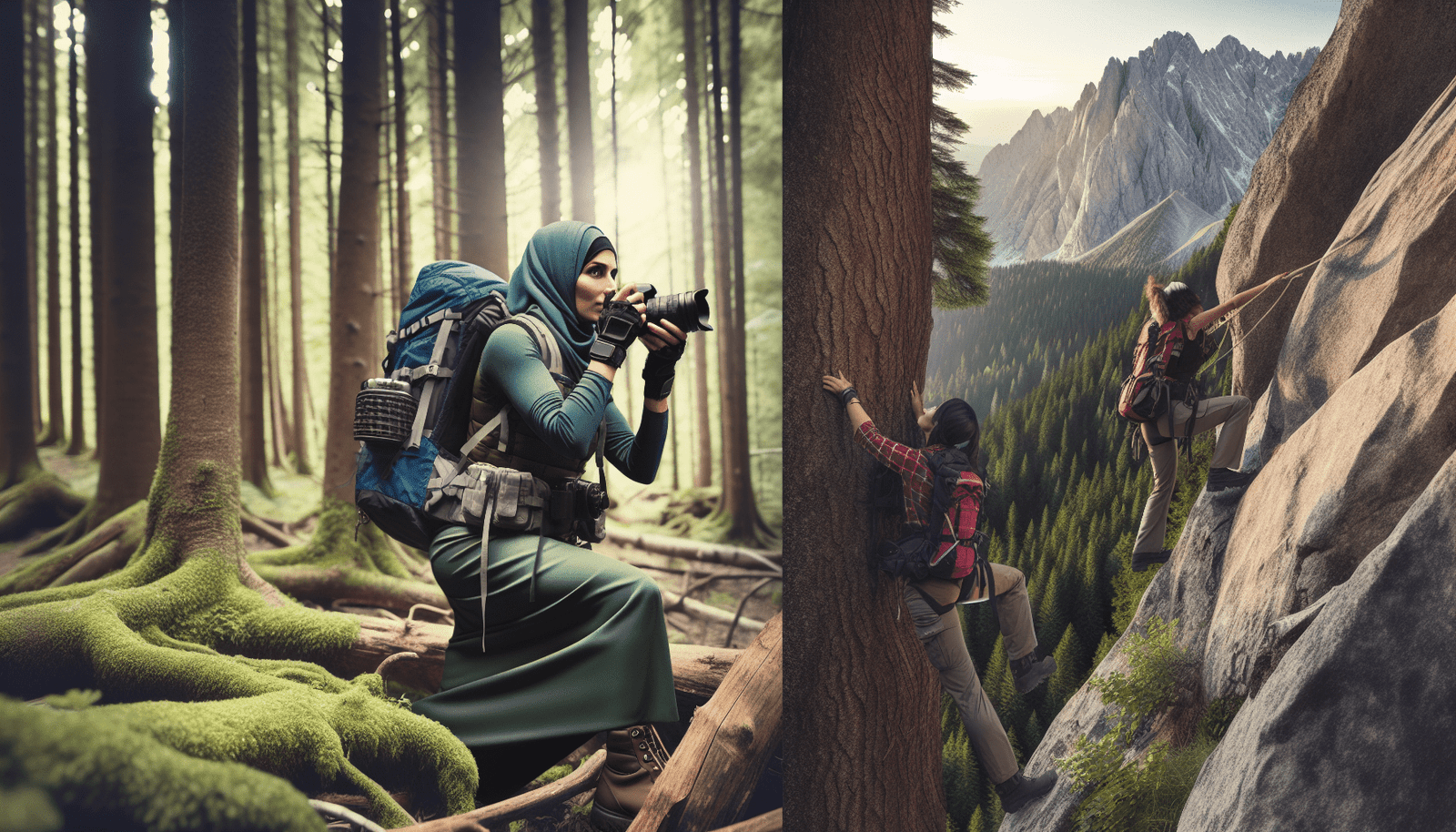Are you a woman with a thirst for adventure and a desire to conquer the great outdoors? Whether you’re an experienced adventurer or just starting out, it’s crucial to have the skills and knowledge to survive in the wilderness. That’s where “The Survivalist Handbook” comes in. Our blog is your go-to resource for all things wilderness survival, with a special focus on providing tips and techniques tailored specifically for women. From building a fire to foraging for food, we’ve got you covered. Get ready to empower yourself and thrive in any wilderness environment!

Self-Defense
Basic self-defense techniques
When navigating the wilderness, self-defense skills are crucial to ensure your safety. Knowing basic self-defense techniques can provide you with the confidence and ability to protect yourself if the need arises. These techniques include strikes to sensitive areas such as the eyes, throat, or groin, as well as basic blocking and evasion maneuvers. It is important to regularly practice these techniques to develop muscle memory and improve your reaction time. By familiarizing yourself with these skills, you can increase your chances of escaping dangerous situations unharmed.
Carrying self-defense tools
In addition to learning self-defense techniques, carrying self-defense tools can provide you with an extra layer of protection. There are various tools available that are specifically designed for self-defense, such as pepper spray, personal alarms, and tactical pens. Pepper spray can temporarily incapacitate an attacker, giving you the opportunity to escape. Personal alarms emit a loud sound that can attract attention and deter potential threats. Tactical pens are multi-purpose tools that can serve as a self-defense weapon and also function as a pen. Carrying these tools and knowing how to use them effectively can enhance your personal safety while in the wilderness.
Navigating the Wilderness
Using a compass and map
When venturing into the wilderness, it is essential to know how to navigate using a compass and map. These tools can help you determine your exact location, plan your route, and avoid getting lost. A compass provides you with the ability to determine directions by using the Earth’s magnetic field. By understanding how to read a compass and orient yourself with a map, you can confidently navigate through unfamiliar terrain and reach your desired destination.
Reading natural landmarks
In addition to using a compass and map, reading natural landmarks can be an invaluable skill when navigating the wilderness. Natural landmarks, such as mountains, rivers, and rock formations, can serve as navigational aids and provide essential reference points. By familiarizing yourself with the landscape and identifying these landmarks, you can use them as guideposts to maintain your direction and stay on track.
Following stars at night
Another useful technique for navigating the wilderness is the ability to follow stars at night. In the absence of artificial light, the stars can provide guidance and help you determine which direction you are heading. By studying and identifying different constellations, such as the North Star (Polaris), you can use them as celestial compasses to find your way. Familiarize yourself with star patterns and their correlation to direction so that you can utilize this skill in the wilderness.
Finding Shelter
Identifying suitable shelter locations
Finding suitable shelter is crucial for survival in the wilderness. When searching for shelter, look for natural features that can provide protection from the elements, such as caves, overhangs, or dense tree canopies. Avoid areas prone to flooding or areas with potential hazards, such as loose rock formations. Additionally, consider the availability of resources nearby, such as firewood and water sources, to ensure sustainability during your stay.
Building a shelter using natural materials
If you are unable to find a suitable shelter, knowing how to build one using natural materials is essential. There are various types of shelters you can construct, depending on the resources available and the environmental conditions. These include lean-to shelters, debris shelters, and snow caves. By utilizing materials such as branches, leaves, and rocks, you can create a sturdy and protective shelter that will shield you from the elements and provide a safe haven in the wilderness.
Locating and Purifying Water
Finding water sources
In the wilderness, finding a reliable water source is crucial for survival. It is important to familiarize yourself with different water sources, such as rivers, streams, lakes, or natural springs, and understand how to locate them. Look for indicators such as vegetation or animal tracks that may lead you to water sources. If necessary, use a compass or map to navigate towards known water sources in the area.
Filtering and purifying water
Once you have located a water source, it is essential to filter and purify the water before consuming it. Even seemingly clean water can contain harmful bacteria and parasites that can make you sick. Use a portable water filter or purifier to remove impurities and pathogens from the water. Additionally, boiling the water for at least one minute can further ensure its safety for consumption. Having the knowledge and tools to filter and purify water will help you stay hydrated and prevent waterborne illnesses while in the wilderness.

Foraging for Edible Plants
Identifying edible plants
In a survival situation, knowing how to identify edible plants can be a valuable skill. Many wilderness environments offer a variety of edible plants that can provide essential nutrients and sustenance. Familiarize yourself with common edible plants in the area, such as wild berries, edible greens, and edible roots. Learn to identify these plants based on their distinct characteristics, such as leaf shape, color, and scent. However, it is vital to exercise caution and only consume plants that you are absolutely certain are safe to eat.
Avoiding poisonous plants
While it is crucial to know which plants are edible, it is equally important to be able to identify and avoid poisonous plants. Some plants in the wilderness can be toxic and potentially fatal if ingested. Understand the distinguishing features of poisonous plants, such as distinctive leaf patterns or fruit characteristics. If in doubt, avoid consuming any plant that you are unsure about. Keeping a field guide of local plants or attending a wilderness survival course can enhance your knowledge and confidence in foraging for edible plants.
Fishing and Trapping
Constructing basic fish traps
Fish can be a valuable source of food in a survival situation, and knowing how to construct basic fish traps can greatly increase your chances of catching fish. There are various types of fish traps, such as funnel traps, basket traps, or fish weirs. These traps are designed to attract and catch fish without requiring constant monitoring. By utilizing natural materials such as rocks, sticks, and foliage, you can construct effective fish traps that provide you with a sustainable food source while in the wilderness.
Setting up snares for small game
In addition to fishing, setting up snares for small game can further supplement your food supply in a survival situation. Snares are simple traps that can be constructed using cordage or wire to catch small animals. Identify areas where animal tracks are abundant, such as game trails or near water sources, and set up snares accordingly. Ensure that the snare is set properly, with the noose at the right height and tension, to increase your chances of successfully trapping an animal. Familiarize yourself with local regulations and ethical considerations regarding trapping and hunting before utilizing these techniques.
Preparing a Survival Kit
Essential items to include in a survival kit
A well-prepared survival kit can be a lifesaver in emergency situations. When assembling your survival kit, ensure that it contains essential items that cover the basic necessities for survival. These items include a first aid kit, a reliable knife, fire-starting tools, a signaling device, a compass, a waterproof tarp or shelter, food rations, water purification tablets, and a flashlight. Additionally, consider including items specific to your personal needs or the environment you will be navigating.
Packing a lightweight and compact kit
When packing a survival kit, it is important to prioritize lightweight and compact items to ensure ease of mobility and prevent unnecessary strain. Look for lightweight alternatives for items such as shelter, cooking tools, or water containers. Choose multi-purpose items whenever possible to reduce the number of individual items in your kit. Regularly evaluate and reorganize your kit to keep it lightweight and up-to-date with your specific needs.
Emergency Signaling
Using signaling mirrors
In times of emergency, being able to attract attention and signal for help is crucial. Signaling mirrors are an effective tool for long-range communication in wilderness environments. Hold the mirror in one hand and align it to reflect sunlight towards your target, such as an aircraft or search party. Move the mirror in a sweeping motion to increase the chances of your signal being noticed. Practice using a signaling mirror before venturing into the wilderness to ensure proficiency in this important skill.
Creating smoke signals
In situations where visibility is limited or during nighttime, creating smoke signals can be a viable method of emergency signaling. Build a small fire using dry materials and allow it to produce a thick, steady smoke. Use a blanket or cloth to waft the smoke and create distinctive patterns or bursts. Smoke signals are an internationally recognized distress signal and can attract attention from potential rescuers. Remember to use this method responsibly and only when in a genuine emergency situation.
Dealing with Menstruation
Managing menstrual hygiene in the wilderness
For women in the wilderness, managing menstrual hygiene can present unique challenges. It is essential to plan ahead and pack appropriate supplies, such as sanitary pads or tampons, in your survival kit. Dispose of used products responsibly by burying them in a cat hole at least 200 feet away from any water sources. Regularly change your sanitary products to maintain cleanliness and prevent infection. Proper menstrual hygiene is crucial for your comfort and overall well-being in the wilderness.
Utilizing menstrual cups or alternative products
Alternatively, consider using menstrual cups or other sustainable and reusable period products in the wilderness. Menstrual cups are made of medical-grade silicone and can be worn for up to 12 hours, offering a longer duration of protection compared to traditional sanitary pads or tampons. They are also more environmentally friendly as they can be reused for several years. Familiarize yourself with the proper insertion and removal techniques of menstrual cups before venturing into the wilderness to ensure comfort and functionality.
Mental Preparedness
Developing a positive mindset
In survival situations, your mindset plays a crucial role in determining your ability to overcome challenges. Developing a positive mindset is essential for maintaining mental strength and resilience. Stay optimistic and focus on the tasks at hand rather than dwelling on negative thoughts or worst-case scenarios. Believe in your abilities and stay motivated to overcome obstacles. By maintaining a positive mindset, you can boost your confidence, adaptability, and overall mental well-being in the wilderness.
Coping with fear and stress in survival situations
Fear and stress can significantly impact your decision-making abilities and overall well-being in survival situations. It is important to develop effective coping mechanisms to manage these emotions. Practice deep breathing exercises and mindfulness techniques to help calm your mind and alleviate stress. Utilize positive self-talk and visualization techniques to overcome fear and stay focused. Remember that fear is a natural response, but it should not dictate your actions. By acknowledging and addressing your fears and stressors, you can better navigate and overcome challenges in the wilderness.
By mastering the skills and techniques outlined in this comprehensive guide, you can confidently venture into the wilderness, knowing that you have the knowledge and tools to survive and thrive. Remember, preparation is key, and practice is essential to ensure proficiency in these survival skills. Stay safe, stay prepared, and embrace the adventure that awaits you in the great outdoors!

